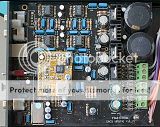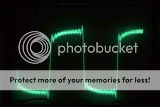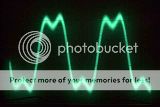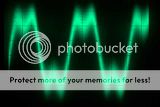I recently bought a WEILIANG DAC5 from China.

It sounds quite nice to me, but I expected better-looking square wave outputs from the MFSL test CD square wave tracks. I used a Win7-64bit machine and standard Windows drivers to drive the USB input to the Tenor TE7022 board, which, in turn, I think, drives the DAC5 via I2S.
1 KHz square wave as seen on my old 100MHZ Tektronix 454 scope at the phono connector output:

and 5KHz square wave:

I've never played with DACs before, but I think there must be some problems with this DAC. Can anyone with more familiarity with DACs give me a clue what might cause such distorted wave forms?
Dave

It sounds quite nice to me, but I expected better-looking square wave outputs from the MFSL test CD square wave tracks. I used a Win7-64bit machine and standard Windows drivers to drive the USB input to the Tenor TE7022 board, which, in turn, I think, drives the DAC5 via I2S.
1 KHz square wave as seen on my old 100MHZ Tektronix 454 scope at the phono connector output:

and 5KHz square wave:

I've never played with DACs before, but I think there must be some problems with this DAC. Can anyone with more familiarity with DACs give me a clue what might cause such distorted wave forms?
Dave
Last edited:
Hi,
square wave require a very large bandwith to be perfectly reproduced. That's not what you expect from an audio dac.
To measure it's performance, at least with the USB entry, you can use the RMAA (rightmark audio, free) software. Then perform a loopback measurement. You need a good soundcard with line level input to do that accurately. The performance of soundcards (distorsion) are much better than the best scopes.
BTW, I am interested by the "simplified" version of this dac with only USB input. It's named DAC6. (search ebay for USB DAC TE7022 WM8741)
I have some questions but ebay vendors are ... vendors !
Did you get the schematic of your dac ? if yes, from which vendor ?
thanks
square wave require a very large bandwith to be perfectly reproduced. That's not what you expect from an audio dac.
To measure it's performance, at least with the USB entry, you can use the RMAA (rightmark audio, free) software. Then perform a loopback measurement. You need a good soundcard with line level input to do that accurately. The performance of soundcards (distorsion) are much better than the best scopes.
BTW, I am interested by the "simplified" version of this dac with only USB input. It's named DAC6. (search ebay for USB DAC TE7022 WM8741)
I have some questions but ebay vendors are ... vendors !
Did you get the schematic of your dac ? if yes, from which vendor ?
thanks
I would be quite concerned about those waveforms, myself. Setting aside the fact that I am convinced that Wolfson dacs are terrible, it certainly looks like there is something wrong with the output section design, as the 1k wave shows a clear audio range frequency response problem. If you do a simple 20Hz-20kHz sinewave sweep(or at 1/3 octave steps), I think you will see a quite less than flat response curve. You can, and should, also look at your squarewaves directly at the output pins of the dac chip. That will, of course, tell you right away if it's an analog or digital fault, and/or if the Wolfson chips suck even worse than I thought.🙂.
And I would never, personally, depend on a computer soundcard to be half as clean & reliable a waveform display tool as a good scope(and I have owned a 454, now have a far newer & nicer Tek). Computers are horribly noisy environments, electrically.
And I would never, personally, depend on a computer soundcard to be half as clean & reliable a waveform display tool as a good scope(and I have owned a 454, now have a far newer & nicer Tek). Computers are horribly noisy environments, electrically.
Hi alkasar,
Interesting...thank you. I will give RMAA software a try.
I could not find the DAC6 on ebay, but I did find it on taobao. This is probably what you're looking at:
http://www.smalltao.com/product/16447812283/DAC6 extreme pure USB decoding TE7022 - span classHWM 8 741-span finished boards non-kit
I'd be interested in seeing the schematic of the DAC6, if you happen to find it.
I found a schematic of my DAC5, but the taobao vendor I bought from refused to give it to me. I had originally thought about buying the kit version of the DAC5 from
http://www.nutsAudio.com
but finally decided to buy the assembled version. Anyway, Pan at nutsaudio.com was kind enough to send me the schematic of the DAC5.
I have since replaced the NE5532 and NE5534 op amps in my DAC5 with LME49860 and LME49870. Unfortunately my tweeters blew out, so I haven't had a chance to listen yet.
Dave
Interesting...thank you. I will give RMAA software a try.
I could not find the DAC6 on ebay, but I did find it on taobao. This is probably what you're looking at:
http://www.smalltao.com/product/16447812283/DAC6 extreme pure USB decoding TE7022 - span classHWM 8 741-span finished boards non-kit
I'd be interested in seeing the schematic of the DAC6, if you happen to find it.
I found a schematic of my DAC5, but the taobao vendor I bought from refused to give it to me. I had originally thought about buying the kit version of the DAC5 from
http://www.nutsAudio.com
but finally decided to buy the assembled version. Anyway, Pan at nutsaudio.com was kind enough to send me the schematic of the DAC5.
I have since replaced the NE5532 and NE5534 op amps in my DAC5 with LME49860 and LME49870. Unfortunately my tweeters blew out, so I haven't had a chance to listen yet.
Dave
Let me disagree. Square wave is not what you want to measure to qualify a dac. This dac has an output LPF that limits -on purpose- the bandwith to eliminate HF noise. Eventhough you seem to dislike wolfson for some unclear reason, the datasheet of WM8741 is pretty clear.I would be quite concerned about those waveforms, myself. Setting aside the fact that I am convinced that Wolfson dacs are terrible, it certainly looks like there is something wrong with the output section design, as the 1k wave shows a clear audio range frequency response problem.
If you do a simple 20Hz-20kHz sinewave sweep(or at 1/3 octave steps), I think you will see a quite less than flat response curve. You can, and should, also look at your squarewaves directly at the output pins of the dac chip. That will, of course, tell you right away if it's an analog or digital fault, and/or if the Wolfson chips suck even worse than I thought.🙂.
And I would never, personally, depend on a computer soundcard to be half as clean & reliable a waveform display tool as a good scope(and I have owned a 454, now have a far newer & nicer Tek). Computers are horribly noisy environments, electrically.
Sinewave sweep is indeed more accurate to measure a dac. This is what RMAA does. It does also a bunch of other stuff. It's not the only software doing that, I like because it's free, accurate and automated. Of course, you need a soundcard at least as good as the device you measure.
A good Audio soundcard has limited bandwith but has much better distorsion & noise floor figures for a fraction of the price. I have an EMU 0204 usb soundcard used with a soft-scope on a notebook. No way for the scope to beat 117dB SNR / 0.0008% THD. You must have a very bad pc if the noise of the pc pollutes the sound card!
I own a digital Scope as well , it's strengh is the bandwith 😉
Thanks Dave for the links. I don't dare go direct ot taobao. Many vendors have these dacs on ebay 😉 Good to know that the schematics is available. I have to find a vendor that will agree to send it to me.Hi alkasar,
Interesting...thank you. I will give RMAA software a try.
I could not find the DAC6 on ebay, but I did find it on taobao. This is probably what you're looking at:
http://www.smalltao.com/product/16447812283/DAC6 extreme pure USB decoding TE7022 - span classHWM 8 741-span finished boards non-kit
I'd be interested in seeing the schematic of the DAC6, if you happen to find it.
I found a schematic of my DAC5, but the taobao vendor I bought from refused to give it to me. I had originally thought about buying the kit version of the DAC5 from
http://www.nutsAudio.com
but finally decided to buy the assembled version. Anyway, Pan at nutsaudio.com was kind enough to send me the schematic of the DAC5.
I have since replaced the NE5532 and NE5534 op amps in my DAC5 with LME49860 and LME49870. Unfortunately my tweeters blew out, so I haven't had a chance to listen yet.
Dave
My concern about DAC6 is the output Low Pass Filter. It is there on DAC5 but seems missing on DAC6 (only one opamp on board, probably used as buffer).
Al
I must confess that I am a bit confused. I wish I could measure the output of this DAC in the time domain, but I do not own a spectrum analyzer. Would RMAA give me this ability? It looks as if it does FFTs. Would RMAA also give me hints as to how to interpret its results?
I have downloaded both the executable file and the user's guide for RMAA (which I have briefly looked at), but I fear that the built-in ADC in my computer is not as capable as the DAC I'd like to test.
How could a swept sine wave show different results from a square wave on a time domain plot?
I have downloaded both the executable file and the user's guide for RMAA (which I have briefly looked at), but I fear that the built-in ADC in my computer is not as capable as the DAC I'd like to test.
How could a swept sine wave show different results from a square wave on a time domain plot?
Sinewave sweep is indeed more accurate to measure a dac. This is what RMAA does. It does also a bunch of other stuff. It's not the only software doing that, I like because it's free, accurate and automated. Of course, you need a soundcard at least as good as the device you measure.
)
DAC
I recently bought a WEILIANG DAC5 from China.
Hi,
I also bought the same DAC (only diff. is mine output IC is a AD827).As seller asks ,i connect it with a transformer 15VAC (50VAC output),and a 12 Volt DC (i don't have a 9 Volt AC) by pass the LM317*.Once power it up ,
the red pilot light is on .Hooking it to a computer USB output ,the other led
now is on too (i guess the power from the USB computer )
BUT NO SOUND COMES OUT
I can't leave it ON any longer ,it may harm the unit and seller is NO help :all he offers is how to adjust the output ,and that is it .It is brand new unit ,and this is my 1st DAC from China .
SOMEONE HELP , PLEASE .
Sorry, where I wrote "time domain" above, I should have written "frequency domain."
HOPHANTHIET/SANTA, I think you must have the DAC6 board if there's only the AD827 at the output. That is not the same board I have. I have the DAC5.
Comparing the photos of the DAC6 with my knowledge of the DAC5, I think you need two 15VAC transformer secondary windings, plus one 9VAC secondary winding. One 15VAC winding most likely feeds an LM317 circuit to produce +12VDC, and the other 15VAC winding most likely feeds an LM337 circuit to produce -12VDC.
If you're bypassing the LM317 with your own +12VDC, are you feeding your 15VAC to the LM337 circuit?
I believe you MUST also have 9VAC to feed a 7805 circuit. Without this supply, I don't think there is any way to make the DAC6 work.
This is all conjecture on my part, of course. I suggest you try to obtain a schematic for the DAC6 and go from there.
HOPHANTHIET/SANTA, I think you must have the DAC6 board if there's only the AD827 at the output. That is not the same board I have. I have the DAC5.
Comparing the photos of the DAC6 with my knowledge of the DAC5, I think you need two 15VAC transformer secondary windings, plus one 9VAC secondary winding. One 15VAC winding most likely feeds an LM317 circuit to produce +12VDC, and the other 15VAC winding most likely feeds an LM337 circuit to produce -12VDC.
If you're bypassing the LM317 with your own +12VDC, are you feeding your 15VAC to the LM337 circuit?
I believe you MUST also have 9VAC to feed a 7805 circuit. Without this supply, I don't think there is any way to make the DAC6 work.
This is all conjecture on my part, of course. I suggest you try to obtain a schematic for the DAC6 and go from there.
Let me disagree. Square wave is not what you want to measure to qualify a dac. This dac has an output LPF that limits -on purpose- the bandwith to eliminate HF noise. Eventhough you seem to dislike wolfson for some unclear reason, the datasheet of WM8741 is pretty clear.
My point about the squarewave is that it is CLEARLY showing skewed frequency response WELL within the audio band, in fact mostly at the lower end of the audio band. This is NOT due to any LPF function intended for the dac hf noise. This shows something is not right somewhere. And that 5kHz wave is really very disturbing in character, again showing audio band response problems.
And my Tek scope can easily do -120dBV, and distortion there is simply not present in any significant way. I'm old, and I simply don't trust any computer to not pollute results. If you actually look at the noise levels on the power supply lines inside any computer, you wouldn't trust the results either. And supply line noise is FAR from the only noise source in a pc.
RMAA will do sweep sine to provide frequency domain information.
for example, my measurement in loopback of my own soundcard (akm4396 dac)
RightMark Audio Analyzer test : E-MU0204 24-96
for example, my measurement in loopback of my own soundcard (akm4396 dac)
RightMark Audio Analyzer test : E-MU0204 24-96
Yes, I think you're right. I need to do a sweep sine wave test. But I have absolutely no confidence in the built-in ADC in my computer. So I'm thinking about a way to do this with an oscilloscope. Perhaps a long exposure of the camera while the sweep takes place would reveal something. Or maybe a low-pass filter on the input to the scope might give me a relative reading of the RMS at a particular time. A long sweep and a long exposure of the camera might be able to capture it.
What do you think, short of me buying a really expensive ADC with some sort of USB input to the computer?
Dave
What do you think, short of me buying a really expensive ADC with some sort of USB input to the computer?
Dave
RMAA will do sweep sine to provide frequency domain information.
for example, my measurement in loopback of my own soundcard (akm4396 dac)
RightMark Audio Analyzer test : E-MU0204 24-96
do a sweep sine without the proper-equipment with just a scope is beyond my knowledge 😱
if your computer has line input, you can run RMAA in loopback (output straight into line-input) and measure how good, or how bad, your computer audio is.
IHMO, use your computer soundcard is sufficient to get the frequency response of the dac5 and have a first understanding if there is, or not, a big issue. If you find an issue at some freq, then you can use your scope to investigate more precisely.
if your computer has line input, you can run RMAA in loopback (output straight into line-input) and measure how good, or how bad, your computer audio is.
IHMO, use your computer soundcard is sufficient to get the frequency response of the dac5 and have a first understanding if there is, or not, a big issue. If you find an issue at some freq, then you can use your scope to investigate more precisely.
Here are the results I get from RMAA 6 comparing the DAC5 output against my computer's speaker out, as seen at my computer's line in:
RightMark Audio Analyzer test: comparison
Dave
RightMark Audio Analyzer test: comparison
Dave
humm.. seems indeed the bandpass is limited in the heights. The low pass filter comes in a bit early. Without surprise, the other measurements are not up to expectaions due to the fact the soundcard input is the weak point.
According to schematic, the dac5 output filter follows almost exactly Wolfson recomandation and should filter above 100k with no impact in the audio range.
Here is the output stage of the dac5 in an on-line simulator
https://www.circuitlab.com/circuit/82953c/dac5-output-lpf/
Can you recheck the components values on board ?
BTW: In RMAA you can specify a range 20-20kHz instead of 40-15kHz. More common for the results in the first table.
Can you run a test at 48kHz ? also make sure you adjust volumes in your audio driver to measure in the best conditions. You can see that real time in the home window of RMAA.
According to schematic, the dac5 output filter follows almost exactly Wolfson recomandation and should filter above 100k with no impact in the audio range.
Here is the output stage of the dac5 in an on-line simulator
https://www.circuitlab.com/circuit/82953c/dac5-output-lpf/
Can you recheck the components values on board ?
BTW: In RMAA you can specify a range 20-20kHz instead of 40-15kHz. More common for the results in the first table.
Can you run a test at 48kHz ? also make sure you adjust volumes in your audio driver to measure in the best conditions. You can see that real time in the home window of RMAA.
Thanks very much for looking at these results. I will change the default range and try again. I will also run a test at 48Khz.
I tried various levels into the DAC. I seemed to get the least distortion and lowest noise floor with the computer's output level control at 100%. That required me to set the line-in levels at what I thought were ridiculously low levels, such as 3%. Maybe I need a resistive pad between the DACs output and line-in on my computer.
I noticed when I was measuring some DAC chip outputs that some of the values of capacitors on the board in the LPF were not as specified in the schematic, but they were not far off, either. I'll provide the exact values as my sample was built.
That's an interesting simulator you're using. I tried out the simulation, and the output looked flat to 20 KHz and almost to 40KHz. I'm not sure what to make of the -14 degree value at 20 KHz. I guess group delay is not flat to 20 KHz?
Dave
I tried various levels into the DAC. I seemed to get the least distortion and lowest noise floor with the computer's output level control at 100%. That required me to set the line-in levels at what I thought were ridiculously low levels, such as 3%. Maybe I need a resistive pad between the DACs output and line-in on my computer.
I noticed when I was measuring some DAC chip outputs that some of the values of capacitors on the board in the LPF were not as specified in the schematic, but they were not far off, either. I'll provide the exact values as my sample was built.
That's an interesting simulator you're using. I tried out the simulation, and the output looked flat to 20 KHz and almost to 40KHz. I'm not sure what to make of the -14 degree value at 20 KHz. I guess group delay is not flat to 20 KHz?
Dave
Unfortunately the free copy of RMAA that I downloaded will not let me edit the range for frequency response. I even changed the values in the Windows registry to 20-20kHz, but, the program immediately changed them back to 40-15kHz as soon as I started it, and it wrote 40-15kHz back to the registry. Maybe only the Pro version allows you to look at a wider spectrum.
Anyway, here are my results at 48kHz:
RightMark Audio Analyzer test: comparison
Anyway, here are my results at 48kHz:
RightMark Audio Analyzer test: comparison
oops, you're right! Needs PRO version. In the interactive screens you can see the -3dB freq when move the mouse on the curve.
The measurement at 48kHz is strange as even the green curve shows a cut at about 15kHz 😕
You can also try ARTA Steps. it performs sweep sine and provides very accurate measurements.
The measurement at 48kHz is strange as even the green curve shows a cut at about 15kHz 😕
You can also try ARTA Steps. it performs sweep sine and provides very accurate measurements.
I have a newer version of this board V1.7. I'm not sure of the differences but there are 2 small dip switches on this version.
I also fitted OPA827 and LT1364 Opamps.
The seller was eBay Australia: Buy new & used fashion, electronics & home d?r
I also fitted OPA827 and LT1364 Opamps.
The seller was eBay Australia: Buy new & used fashion, electronics & home d?r
Attachments
- Home
- Source & Line
- Digital Source
- WEILIANG DAC5 - WM8741 & Tenor TE7022



